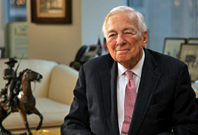 In order to effect social change, nonprofits must have strong leadership and management.
In order to effect social change, nonprofits must have strong leadership and management.Such a statement may seem almost too obvious to mention. Clearly, the strategic success of an organization rests in large part on the management team's shoulders. Yet, some nonprofit leaders have not received management training, and so rely too heavily on vision and charisma in their leadership. Skills like establishing clear organizational priorities and providing employees with performance feedback can mean the difference between good and great results.
Enter John Whitehead. The famed Wall Street executive and former deputy secretary of state is one philanthropist interviewed for our Conversations with Remarkable Givers series who has worked hard to create strong nonprofit leadership. Whitehead became increasingly aware of the widespread lack of nonprofit management experience over his many years of nonprofit board service. "I realized that there was no school that prepared people for nonprofit careers," he says. "It’s a very demanding job and there are lots of things that a nonprofit manager should know and learn about." So in the early 1990s, he persuaded Harvard Business School's then-Dean John McArthur to "become interested in setting up a program at the school to not just train people for private sector careers, but to train people for nonprofit careers, too."
Thanks in large part to Whitehead's vision and efforts, in 1993, the Social Enterprise Initiative launched under the leadership of Professors James E. Austin and V. Kasturi Rangan, with founding support from the John C. Whitehead Fund for Not-for-Profit Management. Through the popularity of the first class, which dealt with entrepreneurship in the social sector, faculty quickly realized such material met a hitherto unmet demand from students who wanted to go into nonprofit careers, says Whitehead. Since then, HBS's Social Enterprise Initiative has blossomed into an increasingly important component of the school, evidenced by programs such as the Leadership Fellows program, which pairs nonprofit and public-sector organizations with graduating MBAs for one year at a salary partially subsidized by Harvard Business School. And the contribution that the Social Enterprise Initiative makes to the thinking around nonprofit topics is tremendous. For example, nonprofit strategy, business leadership in the social sector, public education, global poverty, and other important areas have been examined at forums and conferences sponsored by the Social Enterprise Initiative. In addition, Whitehead points out that business schools throughout the country have adopted similar social enterprise programs, which "has resulted in the management of nonprofits gradually being improved."
Where to find nonprofit leaders? John Whitehead turns to Harvard Business School
In addition to his pioneering work at Harvard and his chairmanship of Goldman Sachs, Whitehead is also the chairman emeritus/board member of a variety of nonprofit organizations, including the International Rescue Committee, Goldman Sachs Foundation, United Nations Association, Greater New York Council of the Boy Scouts, Brookings Institution, and many others. Yet, the Social Enterprise Initiative has a special place in his life. "My activity at Harvard Business School with forming [the Social Enterprise Initiative], converting them and everybody converting business schools all across the country to train nonprofit leaders is maybe the biggest contribution I’ve been able to make to the nonprofit world," he observes.
John Whitehead's Key Messages for Other Philanthropists
You can learn more about Whitehead and find a complete archive of his interviews for Conversations with Remarkable Givers on his page.
This post is part of our series focusing on Conversations with Remarkable Givers, our collection of one to three-minute video clips drawn from over 50 original and private interviews with philanthropists and foundation leaders. Our initial launch features more than 400 videos, which will evolve into a library of over 1,000 videos, as we take a deeper look at each donor over the coming months.
Previous Posts in this Series and Related Material
- Creating Win-Win Philanthropy: Three Keys to Josh Bekenstein's Giving
- Eli Broad's Three-Question Investing Test
- Creating an Effective Philanthropy Strategy for 2013: Five Ideas
- A Capstone Career in Philanthropy: Four Guiding Lessons
- Balancing Career and Philanthropy
- The New Breed of Philanthropist: Younger, Involved, and Innovative
- Strongly Led, Under-Managed: How Can Visionary Nonprofits Make the Critical Transition to Stronger Management?
- How to Research a Nonprofit's Leadership


